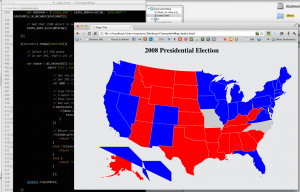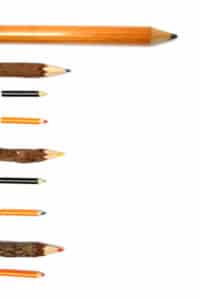Being able to visualize information in the right context is essential to make the correct decisions based on them. That is why you need to work with a radar chart for competitive analysis. Have you ever heard of this graphic format?
Just like other types of graphics like bar charts, histograms, pie charts, and many more, the radar chart can be the best way to display the information you have. During the process of competitive analysis, it calls for such tools to understand what you have learned and obtain the answers you are seeking.
Download this post by entering your email below

Have you ever done a competitive analysis with the right type of data visualization? Stay updated on what your competitors are doing, their results, and how it all affects your business. This not only needs to be developed periodically but also requires the right set of tools.
This is just one example of how interactive content development can drive a positive impact on the strategy of your business. Keep reading and learn more!
Why is competitive analysis so important?
No business can stay afloat by burying its head in the sand and ignoring what is happening around them. You must have processes in place that help you look at what your competitors are doing, how is their performance, and how the market is reacting to that.
A good competitive analysis needs to be part of your ongoing strategies. That is not something to be done once and then forgotten. You must have a constant habit of checking the competition to learn from their successes and mistakes. This is also important to help you anticipate issues that might come up.
 hbspt.cta.load(355484, ‘c060ded0-f017-4df0-92e8-7ace6dd314c0’, {}); To conduct a competent competitive analysis that helps you yield the expected results, use the right tools for capturing data, and visualizing it. That way, you will be able to extract the most strategic diagnosis from your numbers.
hbspt.cta.load(355484, ‘c060ded0-f017-4df0-92e8-7ace6dd314c0’, {}); To conduct a competent competitive analysis that helps you yield the expected results, use the right tools for capturing data, and visualizing it. That way, you will be able to extract the most strategic diagnosis from your numbers.
A good competitive analysis consists of the following elements:
- products and services;
- objectives and KPIs;
- target audiences;
- differentials;
- strengths and weaknesses;
- sales and marketing strategies;
- and others.
What is a radar chart and how can it help?
Your competitive analysis can be greatly improved if it brings the best visualization methods for the information you are gathering. That is the ideal way to extract the right diagnosis to help you develop the correct strategy to beat your competitors.
That is why a radar chart can be your ally in this process. This type of graphic is quite powerful in displaying the relationships between different metrics in a contextualized way, especially if it is used as interactive media. It helps you see a bigger picture and it makes smarter comparisons among your results.
A radar chart is a graphic that displays three or more variables growing out of its core. The length of each axis is proportional to the data they represent, with the largest numbers being longer. A line is traced along this figure to create a shape that represents the unique combination of metrics that the chart has.
Example of a radar chart
Imagine you are deciding between candidates for a position at your company. You have received the results of their evaluations on five important criteria: experience, effectiveness, punctuality, soft skills, and quality of deliveries.
You can display their results using a radar chart on a landing page, with each criteria being represented by an axis coming out of the core. The shape on the graphic can help you see the candidates that fall under categories such as these:
- those who are all-rounders, like those with fuller shapes;
- those who are specialists in specific criteria, like those with sharper shapes;
- those who fail to qualify, like those with a small shape.
How to use a radar chart for competitive analysis?
As you could learn in the previous topic, radar charts are extremely useful to display and understand information. However, did you know you could use this graphic format to help you develop your competitive analysis?
Here are the best tips you need to start using a radar chart for competitive analysis in your business.
Have good data sources
Obtaining data on your competitors is never easy. Some of it is publicly available or can be researched by your team, while other is outright inaccessible as it is probably confidential. This can affect the quality of your competitive analysis.
However, it is still possible to use radar charts to learn more about what paths your business should take concerning your competitors. Make use of the tools you already have, like market statistics, opinion surveys, publicly available information, and others.
Define your analysis criteria
Using a radar chart for competitive analysis allows you to grasp the strengths and weaknesses of your competitors but you must be specific on the criteria you will use. Those will be employed on your radar chart to help you visualize your results more easily.
For instance, those are great criteria you can use to evaluate your competitors: product selection, price, durability, quality, average sales, and others. Each can become a different axis on your graphic to create shapes that help reach a strategic diagnosis.
Use the right tools
There are tools for interactive assessments that help you visualize the data you need in the right formats, like the radar chart. They not only save your time but also make sure you are getting accurate representations.
For that to work, you must seek a tool that has the features you need for your data assessment.
Set your expected result ranges
As the radar chart allows you to see several data points in direct comparison with each other, it is important to think of your expected ranges before you start your competitive analysis with this graphic format.
This will help you know what to look for when comparing your results with those of your competitors. Make sure to draw up the approximate shapes you expect in each scenario.
Compare customer ratings
How do your clients perceive your business and your competitors? A radar chart can help you see how you fare in several different criteria at a glance.
Say you run a survey on the perception of your company and others. You can use each axis of the radar chart to convey how close each one of them is to the ideal score. Then, it is simple to see the fullest shapes as the most positive ones.
Now that you know how to use a radar chart for competitive analysis and the value of doing so, all that is left is defining your strategy. Do not forget that this process needs to be constant, so you can periodically compare your results and follow your progress through time. Also, make sure to consider your reality.
Being able to visualize data the right way is essential to the success of your business. Tell us about your project and get a quote to start working with the best visual content your strategy needs.







